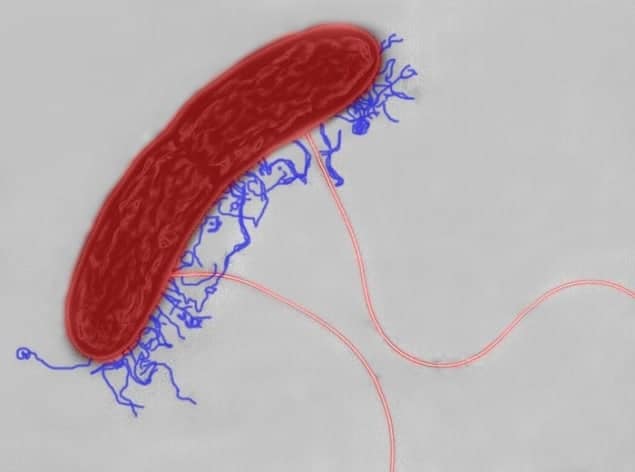
A team of researchers in the US claims to have found clear evidence of a microbe that conducts electricity along protein filaments, just like a metal. By showing that aromatic amino acids are critical to both the electrical and respiratory activities of Geobacter sulfurreducens, the group claims to have unequivocal proof that the bacteria funnel electrons up and down “microbial nanowires” using the exact the same principles as the synthetic organic materials used in electronics.
Geobacter is found in anaerobic soils and sediments the world over. Since its discovery in 1987, it has attracted special attention because of its handy ability to “breathe” pollutants such as iron oxide in mud and wastewater in the way that we breathe oxygen, purifying the source in the process.
Electron transfer is at the heart of all respiration. In order to survive in oxygen-starved environments, Geobacter expels electrons along the fine hair-like filaments it secretes, called pili. “This is unusual because it is using something outside the cell, whereas all other electron acceptors that life uses are typically brought inside the cell,” explains the new study’s lead author, microbiologist Derek Lovley of the University of Massachusetts Amherst in the US.
Biological bombshell
Discovered by Lovley and colleagues in 2005, the pili are only about 5 nm wide but can be up to 20,000 nm in length – many times longer than the bacterial cell itself. In 2011 Lovley’s team went on to show that the pili exhibit metallic-like conductivity, whereby they transport electrons along continuous structures over centimetre distances thousands of times the length of the cell, earning them the nickname “nanowires”.
Physicists tended to take this news in their stride, says Lovley, but the same cannot be said for biologists. “For [us], Geobacter‘s behaviour represented a paradigm shift. It goes against all that we are taught about biological electron transfer, which usually involves electrons hopping [or tunnelling] from one molecule to another,” he explains. It did not help that precisely how the pili were achieving this remarkable feat remained a mystery.
Genetic tweaks
To better understand how this metallic-like conductivity worked, the team looked for inspiration from synthetic organic polymers, the conductivity of which is derived from the overlapping pi–pi orbitals of aromatic compound structures. These ringed structures share electrons suspended in a cloud, which allows the overlapping electrons to flow – a concept that led Lovley to hypothesize that perhaps the aromatic amino acids present in the pili had something to do with their unique properties.
Using genetic-manipulation techniques, the researchers switched the suspect aromatic amino acids in key regions of the Geobacter‘s genome with a non-aromatic amino acid – alanine. The new strain of Geobacter looked identical to the old one under a microscope, but its pili were pitifully poor when it came to electrical conductivity. “It was like pulling the copper out of an extension cord – it still looks the same but it cannot conduct electricity anymore,” Lovley explains.
Critically, the cells were also severely hampered in their ability to dump electrons onto iron oxide in the standard respiration process, implying that conductive pili are central to the biological functioning of the cell. “From my perspective, this is huge,” says Lovley, adding that it “really takes away any conjecture that this might not be important in the biological process”.
Nanowires versus biofilms
And yet, resistance to the idea remains. In 2012 Moh El-Naggar, a physicist from the University of Southern California, and colleagues published results outlining why the Amherst group’s basic hypothesis is physically impossible. Others within the field query the experimental methods used to draw the initial conclusions about the pili’s metallic-like conductivity – including US Naval Research Laboratory researcher Leonard Tender, who published a list of reasons, also in 2012, on why he believes the experiments were flawed. Another researcher, who wishes to remain anonymous, says “Trying to be as objective as possible, I cannot think of anybody in the field who accepts the Lovley group’s hypothesis.”
A particular point of contention is whether the electron-shifting properties of pili can be localized to them alone, or whether the greater “biofilm” that their linked networks form part of – along with the bacterial cells themselves and other extracellular secreted materials such as proteins and polysaccharides – is really responsible.
Compelling evidence
With this latest paper, the tide of opinion might finally be turning in Lovley’s favour though. Christian Pfeffer, from Aarhus University in Denmark – part of a Danish–American team that recently discovered conductive cable-like multicellular bacterial filaments in marine sediments – thinks the study “adds a vital component” to current understanding of Geobacter‘s conductive properties. “I am excited to see whether the ongoing structural studies will soon lead to a model of the actual electron transport, which would also greatly inspire research on other microbial long-distance electron-transport systems,” he says.
Harry Gray of the California Institute of Technology – one of the world’s premier experts on how electrons move in biological systems – says he is “fascinated” by the Geobacter system. “It is clear that electron transport over these very long distances cannot be explained by single-step tunnelling,” he says.
Clearly, the idea that bacteria might conduct electricity like a metal is deeply divisive, but the Amherst group is undeterred. “In biology, it has been a controversial idea ever since we proposed it, which is why we are just keeping after it and trying to learn more,” says Lovley. Next on the researchers’ agenda is an attempt to elucidate the physical structure of the pili, in the hope that this might eventually allow scientists to synthesize similar materials instead of having to grow Geobacter, which is used in bioremediation and microbial fuel cells among other things, in the lab.
The study is published in the open access journal mBio.



